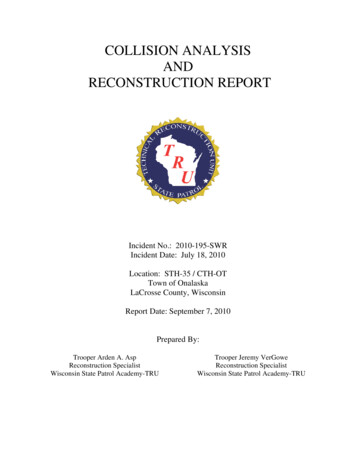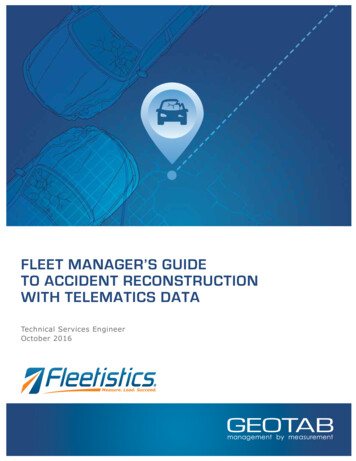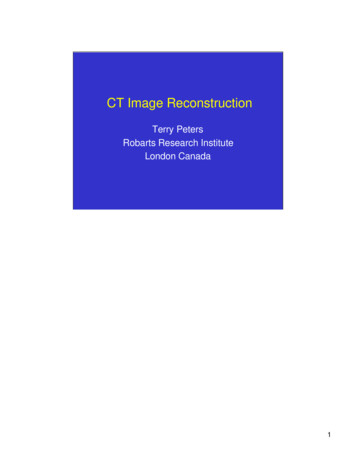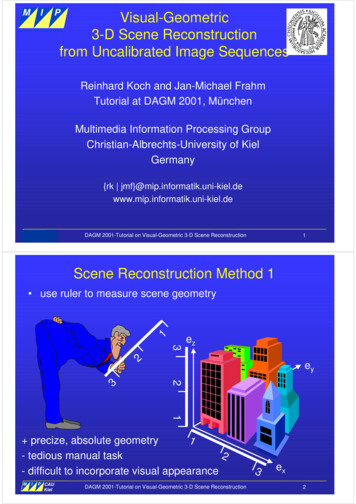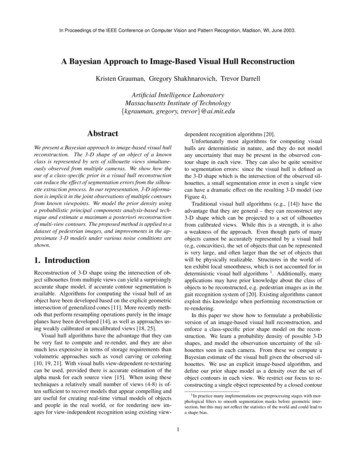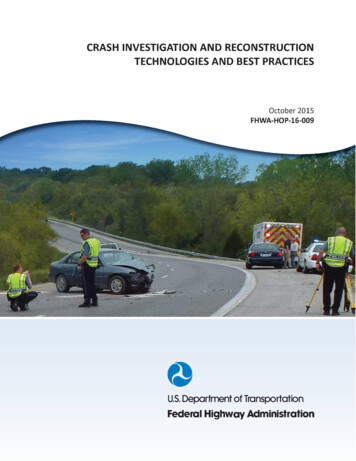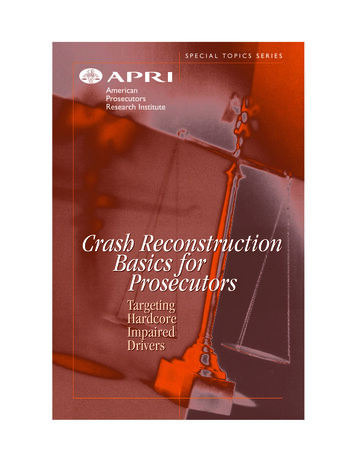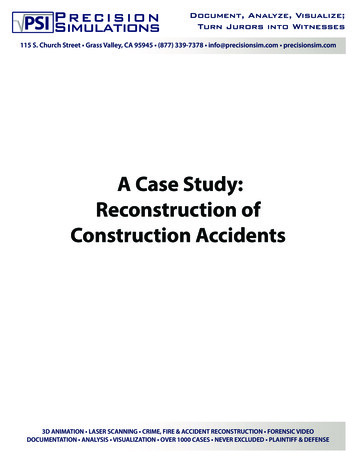
Transcription
Document, Analyze, Visualize;Turn Jurors into Witnesses115 S. Church Street Grass Valley, CA 95945 (877) 339-7378 info@precisionsim.com precisionsim.comA Case Study:Reconstruction ofConstruction Accidents3D ANIMATION LASER SCANNING CRIME, FIRE & ACCIDENT RECONSTRUCTION FORENSIC VIDEODOCUMENTATION ANALYSIS VISUALIZATION OVER 1000 CASES NEVER EXCLUDED PLAINTIFF & DEFENSE
Reconstruction of Construction AccidentsUsing 3D Computer Simulations and Analytical techniques to accurately reconstruct and illustrate an event.The ChallengeHow to develop an accurate reconstruction of a construction workplace injury when the scenehas been completely changed.The SolutionReconstruction of accidents that occurred during construction of a project present a uniquechallenge. By their very nature, construction sites change dramatically over time.Using 3D laser scanning, and laser-assisted photogrammetry with a proprietary analyticalsoftware system, PSI can accurately build a computer generated working model of the sceneas it actually appeared during the accident.PRECISIONSIM.com 877.339.7378 Turn Jurors into Witnesses 2016 Precision Simulations Inc, All Rights ReservedPage 1
PSI Case ExampleScenarioA construction worker is preparing a large re-bar cage to be lifted into place. Behind theworker a front loader operator is moving a large pile of aggregate from one place to another.The operator backs up the front loader crushing the construction worker. The severalwitnesses to the accident offered conflicting testimony.Many photos were taken after the accident. However, the construction site has beensignificantly changed. The photos may not be useful if there are no remaining referencepoints at the original scene. The front loader is available and an aerial photo of theconstruction site taken four months before the accident is also available. The construction worker was seriously injured but is alive, and the front loader operator isavailable for deposition.PRECISIONSIM.com 877.339.7378 Turn Jurors into Witnesses 2016 Precision Simulations Inc, All Rights ReservedPage 2
Incident Site OverviewDate of Aerial Photo: May, 2001Date of Incident: Sept. 7th 2001Gravel PileArea of ImpactRebar CageXRebar CagePhoto taken in 2001 of Subject AreaImmediately after IncidentGravel PilePhoto taken in 2005 of Subject AreaApprox. 4 years Later.PRECISIONSIM.com 877.339.7378 Turn Jurors into Witnesses 2016 Precision Simulations Inc, All Rights ReservedPage 3
QuestionsThe attorney for the defense needed to know:1. Could the operator of the front loader see the construction worker as he backed up?2. Could the construction worker see or hear the front loader backing up?3. Who was at fault? Was there shared responsibility?Visual Comparison Between Front Loader and Construction Worker14.707’Front LoaderConstruction WorkerHeight: 14.7’Height: 5’9”Weight: 20 TonsWeight: 200lbsBright YellowGreen HelmetWarning LightsDark PantsReflective MarkerNO ORANGEVESTBackup Alarm9.323’Reconstruction NeededTo determine what was available to be seen by the operator and the injured worker, theconstruction site had to be reconstructed as it existed when the accident occurred.The true dimensions and location of the re-bar cage also had to be determined withsufficient foundation to be admissible.PRECISIONSIM.com 877.339.7378 Turn Jurors into Witnesses 2016 Precision Simulations Inc, All Rights ReservedPage 4
The 3D Working ModelPSI first laser scanned the construction site to develop an accurate working model of thecurrent site including the adjacent houses. Forensics USA was able to obtain an aerial photograph which included the construction site four months before the accident occurred.Using photogrammetry and proprietary software, PSI was able to determinethe dimensions and location of the re-bar cage and the gravel pit, and place them intothe working model.PSI laser scanned the front loader, created an accurate 3D model and placedit into the working model. The front loader operator was laser scanned sitting in the frontloader, which provided the correct eye position for the working model.The path the injured worker walked just before he was crushed was described byeyewitnesses and placed in the working model as well.A.B.A Computer generated 3D “wire frame”of incident site.B Shaded and textured 3D modelof incident site.PRECISIONSIM.com 877.339.7378 Turn Jurors into Witnesses 2016 Precision Simulations Inc, All Rights ReservedPage 5
The Tools3D Laser ScannerA 3D laser scanner is an advanced type of survey instrument that isused to remotely measure surface geometry of sites and structureswith extraordinary completeness, accuracy and speed.Unlike traditional surveying tools that are used to record certain,selected points within a scene, a 3D laser scanner automatically blankets the scene with millions of closely spaced point measurements.A typical scan may take 5 to 20 minutes; scans are usually done fromseveral different vantage points in order to capture geometry for theentire scene or structure.The front loader operator was laser scanned sitting in the front loader,which provided the correct eye position for the working modelA.B.C.A Subject Front Loader Positioned for Laser ScanB Laser Scan Data ‘Point Cloud”C 3-D Computer Model Created From Laser Scan DataPRECISIONSIM.com 877.339.7378 Turn Jurors into Witnesses 2016 Precision Simulations Inc, All Rights ReservedPage 6
Laser Assisted PhotogrammetryPSI obtained an aerial photo of the site taken months before the accident. Using this information, combined with photos taken on the day of the accident, PSI was able to reconstruct(using photogrammetry) the site as it existed the day of the accident and place this into thecomputer based working model.C.B.A.TreeE.D.TreeA Photo of Tree at Day of IncidentArc Length 37.5’27 FeetX Gravel PileB Aerial Photo of Same Tree a MonthBefore IncidentC Laser Scan Point Cloud of IncidentSite - Top Down ViewD Laser Scan Point Cloud of IncidentSite - Ground ViewRebar CageE CAD Data Derived fromPhotogrammetry Based on Positionof Tree in Aerial Photograph(see B)Using the DataUsing the accurate data derived from the 3D laser coupled with advanced least-squaresalgorithms and the detail available in a photograph, important features from a photograph(see Box B) (even those now missing from the physical scene) can be placed within acomputer-generated working model of a crime accident or fire scene. The accuracy ofthe measurements available from laser-assisted photogrammetry provide not only thenecessary foundation for a valid reconstruction, but also a very realistic, detailed andcompelling animation of the fire, crime or accident scene.PRECISIONSIM.com 877.339.7378 Turn Jurors into Witnesses 2016 Precision Simulations Inc, All Rights ReservedPage 7
Off-Site ReconstructionOnce the placement of the important objects had been determined with photogrammetry,an exemplar site was created in an open field, with each object placed in the correctposition. This allowed the expert and PSI to visualize the accident site, giving everyoneinvolved their first view of the scene as it was at the time of the accident.In addition to visualizing the scene, the exemplar site allowed PSI to perform tests on theperformance capabilities of the front loader, in a functionally similar environment. Two videocameras were set up, along with a surveyed measurement grid, and the front loader wasoperated in the exemplar scene. Speed, acceleration and path of the front loader wasrecorded and analyzed frame-by-frame and then placed into the working model.PRECISIONSIM.com 877.339.7378 Turn Jurors into Witnesses 2016 Precision Simulations Inc, All Rights ReservedPage 8
Visibility AnalysisThe speed, acceleration and path of the front loader as determined by the off-sitereconstruction was placed into the working model. The animator and expert jointlydeveloped an accurate “human head and eye jig” and applied the head turningmovments as described in testimony. The result was an accurate, time-synchronizedreconstruction of the front loader operators’ view. The expert-determined 160 degreefield of view (FOV) was used to evaluate the operators viewpoint.The working model could now be used to simulate what the front loader operator couldactually see as he turned his head left and right whle he backed up the front-loader.The final information needed was the location of the construction worker when the frontloader backed-up. Based on eye witness testimony and the off-site reconstruction, theexpert determined the construction worker’s path and speed (4.4 feet per second).160 Degree Field of View ConePerceptive from 160 Degree Field ofView ConeWith the addition of the expert’s calculated walkingspeed for the construction worker of 4.4 ft/sec, theworking model was complete and ready for analysisof the relative visibility conditions each participant wasfaced with.PRECISIONSIM.com 877.339.7378 Turn Jurors into Witnesses 2016 Precision Simulations Inc, All Rights ReservedPage 9
Animation Analysis2.8 SECONDS 10 FTPerspective View(computer animation)2.8 SECONDS 10 FTOperator could not see construction worker.Worker hidden from view(What constructionworker could see)Front Loader Operator’s View(computer animation)Area of Impact View(video footage)The compelling animation of the front-end loader back up took eight (8) secondsand was accompanied by the loud sound of it’s backup horn.PRECISIONSIM.com 877.339.7378 Turn Jurors into Witnesses 2016 Precision Simulations Inc, All Rights ReservedPage 10
ConclusionOnce the working model was completed, the expert then used it to determine whatthe operator could see when he began to back-up the front-loader. Using 4.4 FPSas the walking speed of the construction worker the computer animation clearlyshowed that the operator could not seethe construction worker at any time duringthe movment of the front loader. The stacklocated in the rear of the loader blockedhis view.The combination of the blocked view of theoperator, combined with the constructionworker’s failure to react to the very largefront loader’s size and noise as ittraveled toward him.In mediation the plaintiff, who neveradmitted to any comparative negligenceby way of Requests for Admissions,lowered their demand in excess of onethird of their pre-mediation demand. Inthis case, the defendants saved inexcess of 2.3 million dollars.The working model provided the defenseattorney a defensible position and twostrong animations of the accident, for acost substantially less than the cost of an actual simulation on site, even if such asimulation would have been possible.Client Comment“Very persuasive. breathes life into complex facts and demonstrates not onlywhat happened, but just as important what did not or could not have happened.”-- Howard Churchill, Esq.Dale, Braden & Hinchcliffe, Pleasant Hill, CAPRECISIONSIM.com 877.339.7378 Turn Jurors into Witnesses 2016 Precision Simulations Inc, All Rights ReservedPage 11
Reconstruction of Construction Accidents 115 S. Church Street Grass Valley, CA 95945 (877) 339-7378 info@precisionsim.com precisionsim.com . 3D ANIMATION LASER SCANNING CRIME, FIRE & ACCIDENT RECONSTRUCTION FORENSIC VIDEO DOCUMENTATION ANALYSIS VISUALIZATION OVER 1000 CASES NEVER EXCLUDED .


